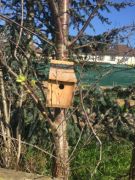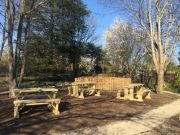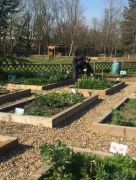Forest School
Our priority is to enable all children to achieve high academic standards. We will also make sure that they develop a sense of social responsibility and a passion for learning.
The Forest School Ethos
Forest School is a unique educational experience and process that offers children the opportunity to succeed and develop confidence and self-esteem through hands-on learning experiences in a woodland or other natural environment.
The Forest School concept originated in Scandinavia and was originally aimed at pre-school children. It was found that children who had attended forest school seemed to benefit in many ways. They arrived at school with strong social and communication skills, had the ability to work in groups effectively, displayed high self-esteem and generally showed confidence in their own abilities.
Since being adopted in the United Kingdom the approach has been used to deliver learning programmes to groups from pre-school age to young adults and across all abilities. Research has shown that the benefits identified in the original forest schools appear to benefit learners at all levels.
Forest School at Springfield provides opportunities for and encourages children to:
- develop their personal and social skills
- develop their language and communication skills
- improve physical motor skills
- work through practical problems and challenges
- develop practical skills
- use tools to create, build or manage
- pursue knowledge that interests them
- build confidence in decision making
- evaluate risk
- explore connections between humans, wildlife and the earth
- reflect on learning and experiences
- regularly experience achievement and success
- learn how to manage failures
- discover how they learn best
- improve their concentration skills
- become more motivated
- understand the benefits of a balanced and healthy lifestyle
The ethos of Forest Schools and the opportunities it provides fit well with the aims of Springfield as outlined in the school prospectus. At Springfield Primary School, we aim to:
- encourage excellence
- value every individual’s contribution
- develop confident, independent learners
- place high emphasis on literacy and numeracy
- encourage aesthetic, spiritual, moral and social development
- develop self-discipline
- teach the children to value and respect self and others
- make learning fun!
Forest School at Springfield
At Springfield, Forest School sessions generally take place within the school grounds. The Burrow area is fully fenced and includes a small area of woodland, hedgerows, recently planted orchard, new woodland planting, grassland and an outdoor classroom.
Forest School sessions are currently run by Mrs Burgess
What do the children do?
Children taking part in Forest School sessions are given an opportunity to participate in activities in a natural setting on a regular basis. The setting provides a safe environment for them to learn and explore. Activities take place throughout the year and in generally in all weathers.
Whilst the sessions may provide opportunities to learn and understand more about the natural world, they also provide opportunities to develop their interpersonal skills.
There are opportunities to learn practical skills that there is often little opportunity to learn in formal school settings or even in the home these days. For tasks such as tree climbing, tool use, fire lighting or cooking there might be an element of managed risk. However, by giving children these opportunities they ultimately become better equipped to manage risk and as a result have the opportunity to grow their self-confidence.
Opportunities for reflection and to share experiences are provided and these help with the social and emotional development of participants. Group size plays an important role in this area, smaller groups allowing, eventually, more in-depth reflection to take place and greater social interaction.
The Forest School leader should be seen as a facilitator. Although activities are well planned, they should essentially be child led. There should be flexibility in the planning to allow children to pursue their interests, planning being used to scaffold their interests. In order for this to happen, leaders need to have a good understanding of practical skills and an ability to match or adapt activities to learner’s interests. Most importantly they need to have a good understanding of the site where the sessions take place and the opportunities it can present.
Activities for Forest Schools are diverse and numerous, but it should be reminded that we are trying to create independent learners who are inspired to try out their own ideas, explore their own interests and to attempt new ideas.
The following will give some indication of the type of activities that might be undertaken:
- Den and shelter building
- Fire lighting
- Tool use
- Wildlife studies
- Habitat development
- Playing team and group games
- Sensory activities
- Tracking games
- Cooking on an open fire
- Rope and string work
- Art and sculpture work
- Woodland and traditional crafts
- Story telling
- Drama
- Imaginary characters
- Physical movement activities
As can be seen the approach is cross curricular.
Forest School Delivery
Forest school sessions at Springfield generally follow a common pattern.
- At the start of each session there will be a short input during which children are reminded of the expectations that are in place for forest school and, any new safety information is relayed. The theme or focus for the week’s activities is then introduced.
- A short starter activity usually then takes place.
- The main activity follows. Activities are commonly offered that link into the interests of the children wherever possible. Where tools are being used there is a high emphasis on safety. If the activity requires a high ratio of supervision the group may be split.
- ‘Free time’ is a key element of the Forest School approach is the opportunity for children to explore a natural environment and pursue their own direction of learning. Therefore, in each session an opportunity for children to pursue their own interests is included. Quite often children will continue with the activity they have started or will continue with something that has sparked their interest in a previous session. Although it is ‘free time’ there are guidelines in place to ensure the safety of all, which participants soon become familiar with.
- Finally, the group is brought together for a period of reflection. This may involve a review of whatever guided activities have taken place or their independent activities. Whilst this is very much a child led activity it may be guided by the Forest School leader when necessary.
Risk Management
Forest School aims to develop children’s self-esteem, independence and motivation to learn in a safe environment. The Forest School Leader will therefore be responsible for conducting appropriate site and activity risk assessments prior to each session. A five-step approach is adopted whereby the following steps are taken:
- Identify hazards and risks.
- Decide who may be harmed and how.
- Evaluate the risks and decide if existing controls are adequate or whether more should be done.
- Record findings, including daily amendments to standing risk assessments based on site visits and observations.
- Review assessments on a regular basis.
Participants, including staff and volunteers, will be informed of potential hazards and methods of working in order to minimise their risk further. When possible, all participants will be involved in the risk assessment process as part of their learning.
Particularly in relation to the use of hand tools and management of fire, participants will be taught appropriate and adequate skills in order to keep themselves safe.
Clothing
As children are potentially outside in all weathers, they need suitable clothing. Outdoor PE kit of tracksuit bottoms, t-shirt, sweatshirt and trainers with an added waterproof jacket meets the basic needs. Wellingtons or walking boots and waterproof over trousers offer greater protection in wet weather conditions. Hat, gloves and scarves are useful throughout the winter months. During the summer period sun hats and sun cream, as outlined in the schools School Sun Safety Policy should be provided.
First Aid
The Forest School leaders have been trained in First Aid. The training undertaken for Springfield teaching staff is appropriate for first aid required in an outdoor setting.
A first aid kit is available on site during each session. When there are fires on site, a fire first aid kit will also be available.
2025-2026 Forest School Calendar
|
Term |
Year Group |
|
Autumn 1 |
Year 5 |
|
Autumn 2 |
Year 4 |
|
Spring 1 |
Year 3 |
|
Spring 2 |
Year 2 |
|
Summer 1 |
Year 1 |
|
Summer 2 |
Reception |
|
Nursery access Forest School every Wednesday. |
|





